Cacti are often admired for their hardy nature and unique shapes. However, many cactus owners wonder how to encourage their plants to bloom. With the right care, even the most reluctant cactus can produce stunning flowers. This guide will walk you through the essential steps to help your cactus reach its full flowering potential.
Understanding the Basics of Cactus Flowering
The Natural Cycle of Cacti
Cacti are native to arid regions, where they have adapted to survive with minimal water and extreme temperatures. In their natural habitat, cacti flower during specific seasons, usually in response to environmental cues such as changes in temperature and light. To encourage flowering, it is crucial to mimic these natural conditions as closely as possible.
Key Factors Influencing Flowering
Several factors play a vital role in cactus flowering. These include light exposure, temperature fluctuations, watering schedules, and nutrient availability. By understanding and manipulating these factors, you can create an optimal environment for your cactus to thrive and bloom.
Providing the Right Light Conditions
The Importance of Light
Light is one of the most critical factors for cactus flowering. Most cacti require plenty of direct sunlight to produce flowers. In general, aim to provide your cactus with at least 6 to 8 hours of bright light per day. If you are growing your cactus indoors, place it near a south-facing window to ensure it receives adequate sunlight.
Adjusting Light for Different Seasons
During the growing season, which typically spans from spring to early fall, your cactus will benefit from maximum light exposure. However, in the winter months, it is essential to reduce the light intensity. This change in light conditions helps signal to the cactus that it is time to prepare for dormancy and, eventually, flowering.
Managing Temperature for Flowering
The Role of Temperature Fluctuations
Cacti are well-adapted to withstand significant temperature changes. In fact, these fluctuations are crucial for triggering the flowering process. During the day, aim to maintain temperatures between 70°F and 80°F (21°C to 27°C). At night, allow the temperature to drop to around 50°F to 60°F (10°C to 15°C). This diurnal temperature variation mimics the natural conditions in the desert and encourages your cactus to bloom.
Creating a Cool Dormant Period
A cool dormant period is essential for many cacti species to flower. During the winter months, reduce the temperature to around 50°F to 55°F (10°C to 13°C) and keep it consistent. This period of rest allows the cactus to conserve energy and prepare for the upcoming flowering season.
Watering and Soil Requirements
Watering Tips for Flowering
Proper watering is another key factor in cactus flowering. Overwatering can lead to root rot and prevent your cactus from blooming. During the growing season, water your cactus thoroughly, allowing the soil to dry out completely between waterings. In the winter, reduce watering to once every few weeks or even less, depending on the humidity levels in your home.
Choosing the Right Soil
The soil you use for your cactus is equally important. A well-draining soil mix is essential to prevent waterlogging and promote healthy root growth. Look for a cactus-specific soil mix that contains perlite, pumice, or coarse sand to improve drainage. You can also add a small amount of organic matter, such as compost, to provide essential nutrients.
Nutrient Support for Flowering
The Role of Fertilizers
While cacti are not heavy feeders, they still require some nutrients to support flowering. A balanced, slow-release fertilizer with equal parts nitrogen, phosphorus, and potassium (N-P-K) is ideal. Apply the fertilizer during the growing season, following the package instructions for the recommended dosage.
Specialized Flowering Fertilizers
For cacti that are reluctant to bloom, consider using a specialized flowering fertilizer. These fertilizers have a higher phosphorus content, which promotes flower development. Apply the flowering fertilizer once a month during the growing season to encourage your cactus to produce buds.
Pruning and Repotting
Pruning for Health and Flowering
Pruning your cactus can help promote healthy growth and flowering. Remove any dead or damaged parts of the plant to prevent disease and encourage new growth. For some cacti species, such as the Christmas cactus, pruning after flowering can help stimulate the production of new buds for the next season.
Repotting Tips
Repotting your cactus every few years can also help support flowering. Choose a pot that is only slightly larger than the current one to avoid overwatering. When repotting, gently remove the cactus from its old pot, trim any damaged roots, and place it in the new pot with fresh soil. Allow the cactus to rest for a week before watering to reduce the risk of root rot.
Common Issues and Troubleshooting
Why Isn’t My Cactus Flowering?
If your cactus is not flowering, there could be several reasons. Insufficient light, improper watering, or inadequate temperature fluctuations are common culprits. Additionally, some cacti species take several years to reach maturity and begin flowering. If you have recently acquired your cactus, it may simply need more time to adjust to its new environment.
Dealing with Pests and Diseases
Pests and diseases can also impact cactus flowering. Common pests include mealybugs and spider mites, which can weaken the plant and prevent it from blooming. Regularly inspect your cactus for signs of infestation and treat any issues promptly with an appropriate insecticide. Fungal infections can also occur if the soil is too wet, so ensure proper drainage and avoid overwatering.
Conclusion
Encouraging your cactus to flower is a rewarding process that requires attention to detail and patience. By providing the right light, temperature, watering, and nutrient conditions, you can create an optimal environment for your cactus to thrive and bloom. With a little care and understanding of your cactus’s needs, you will soon be able to enjoy its beautiful flowers.


